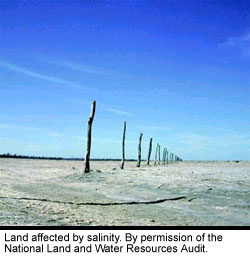|
Although rabbit numbers are tiny compared to their population
during the rabbit plague of the 1930s and 40s, rabbits still cost Australian
farmers more than $600 million every year.
 The
main form of agricultural damage caused by rabbits is loss of pasture
and crops due to grazing. Ten rabbits will eat as much as one sheep; during
the rabbit plague farmers could only run a very small number of stock
because the rabbits were eating so much of the available pasture. Les
McNaboe recalls: "When the rabbits went, the feed just went mad on
all the properties, because they were understocked. They were stocking
to their capacity - but they had to allow a lot for the damn rabbits!" The
main form of agricultural damage caused by rabbits is loss of pasture
and crops due to grazing. Ten rabbits will eat as much as one sheep; during
the rabbit plague farmers could only run a very small number of stock
because the rabbits were eating so much of the available pasture. Les
McNaboe recalls: "When the rabbits went, the feed just went mad on
all the properties, because they were understocked. They were stocking
to their capacity - but they had to allow a lot for the damn rabbits!"
Rabbits will devastate crops, biting off young lupin, wheat and other
plants at ground level. Warrens just under the surface of paddocks also
cause problems. As Lynette Gillam recalls: "You had all this area
in your cropping paddocks that had been rabbit warrens. You couldn't drive
a truck over it. You could drive a light vehicle, or perhaps go over it
with a horse, and even that was dangerous at times. All that had to be
scarified and raked and scarified again so that it was consolidated before
you could put any crops in again."
 When
the land was first cleared, farmers left areas of native vegetation. Unfortunately,
rabbits would move into these areas because they were an ideal refuge
from warren ripping and fumigation. Eventually the native plants and bushes
had to be cleared to get rid of the rabbits. When
the land was first cleared, farmers left areas of native vegetation. Unfortunately,
rabbits would move into these areas because they were an ideal refuge
from warren ripping and fumigation. Eventually the native plants and bushes
had to be cleared to get rid of the rabbits.
Angus Forsyth recalls: "They were clearing these patches of scrub
and so forth, 'cause that's where the rabbits had congregated. I often
think that it's a shame that we had to do that ... we had to hit the rabbit
and clear them out. That necessitated clearing out these clumps of bush,
and a lot of them were left in good faith, quite pretty little outcrops,
'round rocks and places like that. But eventually, in our case, we cleared
them out."
This clearing of native vegetation puts more pressure
on native animals who are deprived of protective cover. It also exposes
the soil to erosion by wind and water, and contributes to the problem
of salinity - very high levels of salt in the soil making it is
impossible to grow any crops.
|